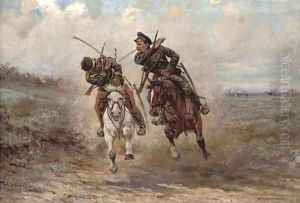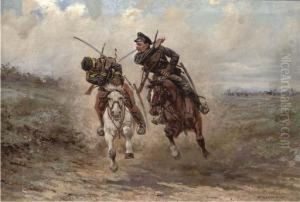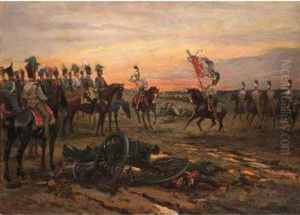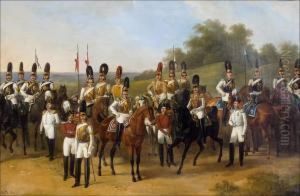Viktor Vinkent'evich Mazurovskii Paintings
Viktor Vinkent'evich Mazurovskii was a Russian artist and architect known for his diverse body of work that spanned various disciplines, including painting, graphic design, and architecture. Born in 1864, in the Russian Empire, Mazurovskii lived through a period of significant historical changes, experiencing the last decades of the Tsarist regime, World War I, the 1917 Russian Revolution, and the early years of the Soviet Union.
Mazurovskii's education and artistic training took place at a time when Russia was experiencing a cultural renaissance, with the influence of European modernism beginning to make its mark on Russian artists. He studied at the Imperial Academy of Arts in Saint Petersburg, where he would have been exposed to both the classical traditions of art and the emerging modernist trends. His work reflects a combination of these influences, with a strong sense of composition and attention to detail that was characteristic of traditional academic art, as well as an interest in exploring new artistic languages and techniques.
Throughout his career, Mazurovskii contributed to the fields of architecture and design. He was part of the movement that aimed to develop a distinctively Russian style of art and architecture, which sought to break away from the heavy influence of European styles. This movement was part of a broader nationalistic trend in the arts, which sought to define and celebrate Russian identity and heritage.
Mazurovskii's architectural works include both public and private commissions, and he was known for his ability to integrate decorative elements into his buildings, creating cohesive and aesthetically pleasing designs. He also produced graphic works, which included illustration, poster design, and book covers, reflecting the growing importance of print media and visual communication in the early 20th century.
The political upheavals of the early 20th century had a profound impact on the arts in Russia, and like many of his contemporaries, Mazurovskii's later career was likely affected by the changing ideological landscape. The rise of the Soviet Union brought about a new cultural policy that favored socialist realism, and artists were often expected to conform to the state's definition of acceptable art.
Viktor Vinkent'evich Mazurovskii's death in 1935 marked the end of a life that had spanned profound transformations in Russian society and art. His legacy lies in his contribution to the architectural and artistic heritage of his country, reflecting the search for a Russian artistic identity during a time of great change.



